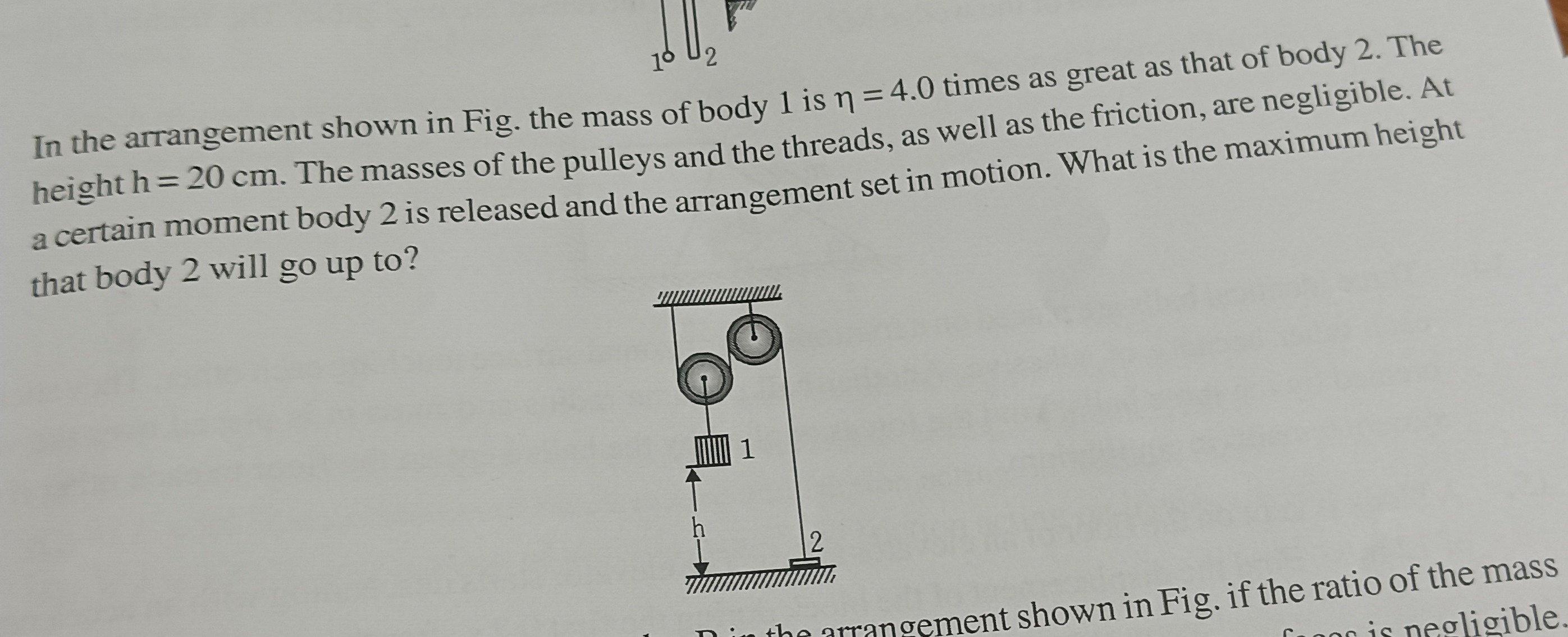Question
Question: In the arrangement shown in Fig. the mass of body 1 is $\eta=4.0$ times as great as that of body 2. ...
In the arrangement shown in Fig. the mass of body 1 is η=4.0 times as great as that of body 2. The height h = 20 cm. The masses of the pulleys and the threads, as well as the friction, are negligible. At a certain moment body 2 is released and the arrangement set in motion. What is the maximum height that body 2 will go up to?

60 cm
Solution
Let m1 and m2 be the masses of body 1 and body 2, respectively. We are given m1=ηm2, with η=4.0.
Let a1 be the downward acceleration of body 1 and a2 be the upward acceleration of body 2.
From the arrangement of the pulleys, if body 1 moves down by a distance x, the movable pulley moves up by x. The string passing over the movable pulley has one end fixed and the other end attached to body 2. If the movable pulley moves up by x and body 2 moves up by y, the length of the string remains constant. The change in the length of the string is the sum of the changes in the lengths of the two vertical segments connected to the movable pulley. The length of the segment between the fixed support and the pulley decreases by x. The length of the segment between the pulley and body 2 changes by (y−x). The total change in length is −x+(y−x)=y−2x. Since the length is constant, y−2x=0, so y=2x. Thus, the upward displacement of body 2 is twice the downward displacement of body 1. Differentiating twice with respect to time, we get a2=2a1.
Let T1 be the tension in the string connected to body 1, and T2 be the tension in the string passing over the movable pulley.
For body 1 (moving downwards): m1g−T1=m1a1.
For body 2 (moving upwards): T2−m2g=m2a2.
For the movable pulley (mass is negligible): The net force on the pulley is zero. The upward force is T1 and the downward forces are 2T2. So, T1−2T2=0, which means T1=2T2.
Substitute T1=2T2 into the equation for body 1: m1g−2T2=m1a1.
From the equation for body 2, T2=m2g+m2a2.
Substitute T2 into the modified equation for body 1: m1g−2(m2g+m2a2)=m1a1.
m1g−2m2g−2m2a2=m1a1.
Substitute a2=2a1: m1g−2m2g−2m2(2a1)=m1a1.
m1g−2m2g−4m2a1=m1a1.
(m1−2m2)g=(m1+4m2)a1.
a1=m1+4m2(m1−2m2)g.
Given m1=ηm2=4m2,
a1=4m2+4m2(4m2−2m2)g=8m22m2g=4g.
The downward acceleration of body 1 is a1=g/4.
The upward acceleration of body 2 is a2=2a1=2(g/4)=g/2.
Initially, body 1 is at height h=20 cm =0.20 m above the floor, and body 2 is on the floor. The system starts from rest.
Body 1 moves down with acceleration a1=g/4. It hits the floor when it has moved a distance h.
Using the kinematic equation s=ut+21at2, with initial velocity u=0, displacement s=h, and acceleration a=a1:
h=0⋅t+21a1t2=214gt2=8gt2.
The time taken for body 1 to hit the floor is t=g8h.
During this time t, body 2 moves upwards with acceleration a2=g/2. The distance moved by body 2 is y2=ut+21a2t2, with initial velocity u=0:
y2=0⋅t+21a2t2=4gt2.
Substitute t2=g8h:
y2=4g(g8h)=2h.
So, when body 1 hits the floor, body 2 has moved up by a distance 2h. The height of body 2 at this moment is 2h.
At the moment body 1 hits the floor, the velocity of body 2 is v2=u+a2t=0+a2t=2gg8h=2gg22h=2gh.
After body 1 hits the floor, the string connected to it becomes slack, and body 2 is no longer connected to body 1. Body 2 is now moving upwards with initial velocity v2=2gh and is under the influence of gravity only. Its acceleration is now −g (downwards).
Body 2 will continue to move upwards until its velocity becomes zero. Let the additional height it goes up be Δh2.
Using the kinematic equation v2=u2+2as, with final velocity v=0, initial velocity u=v2, acceleration a=−g, and displacement s=Δh2:
02=v22+2(−g)Δh2.
0=(2gh)−2gΔh2.
2gΔh2=2gh.
Δh2=h.
The total maximum height that body 2 will go up to is the height it reached when body 1 hit the floor plus the additional height it goes up afterwards.
Maximum height =y2+Δh2=2h+h=3h.
Given h=20 cm, the maximum height is 3×20 cm =60 cm.
